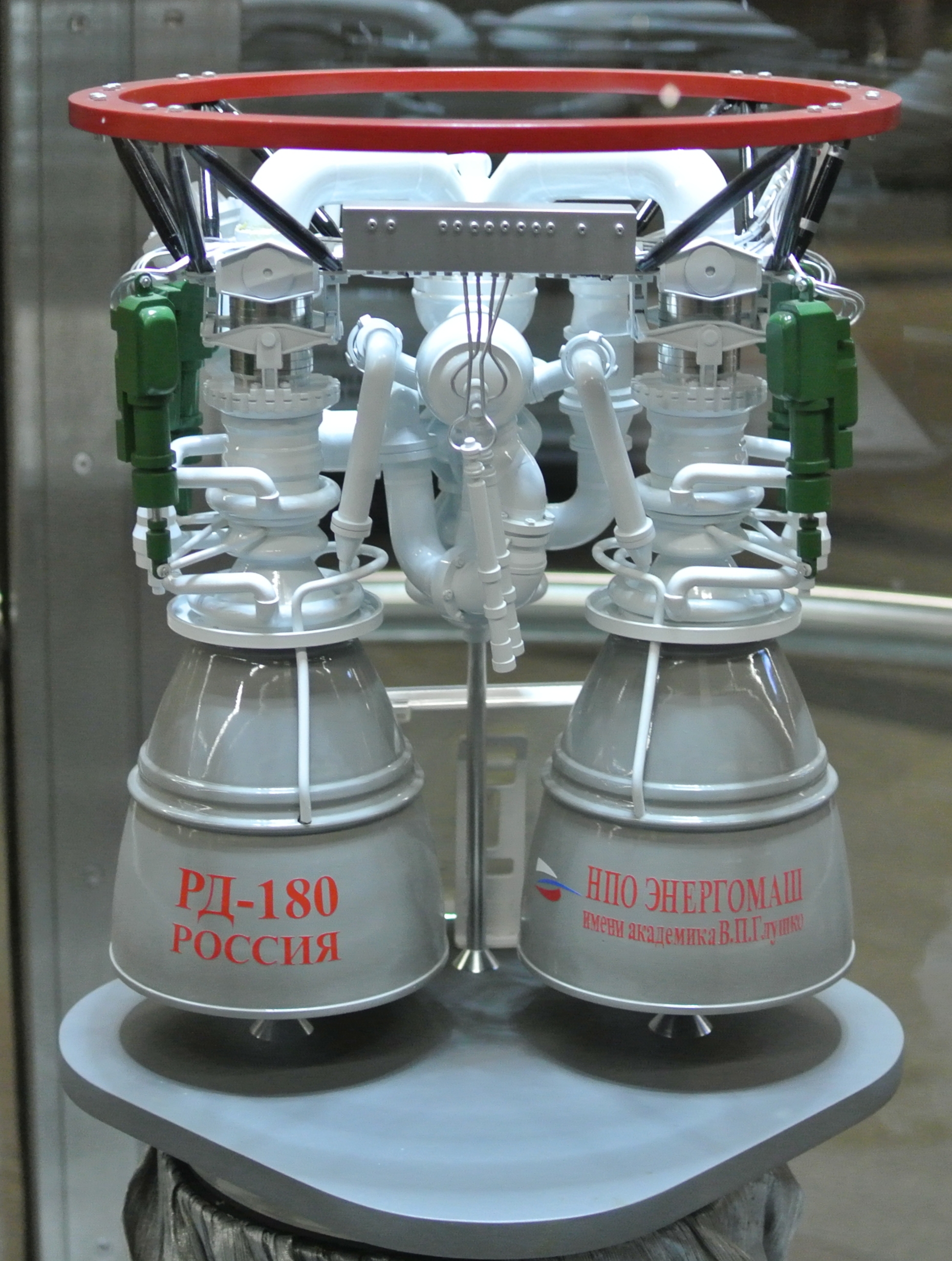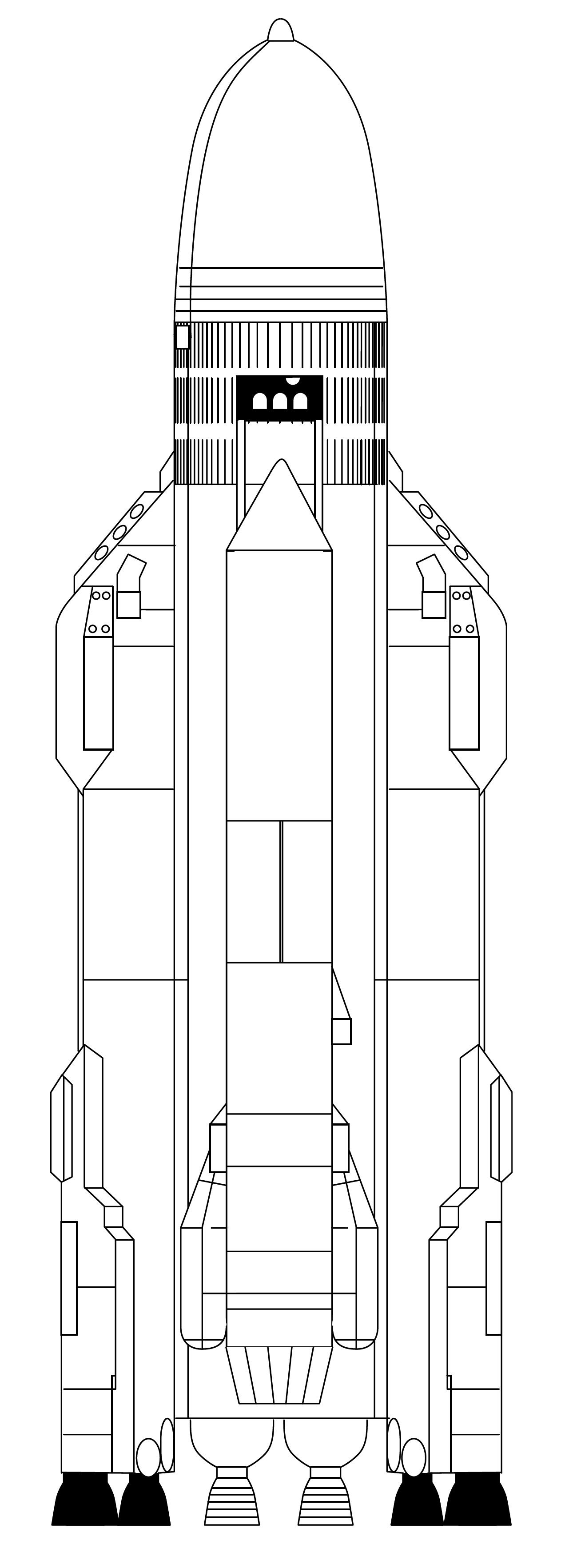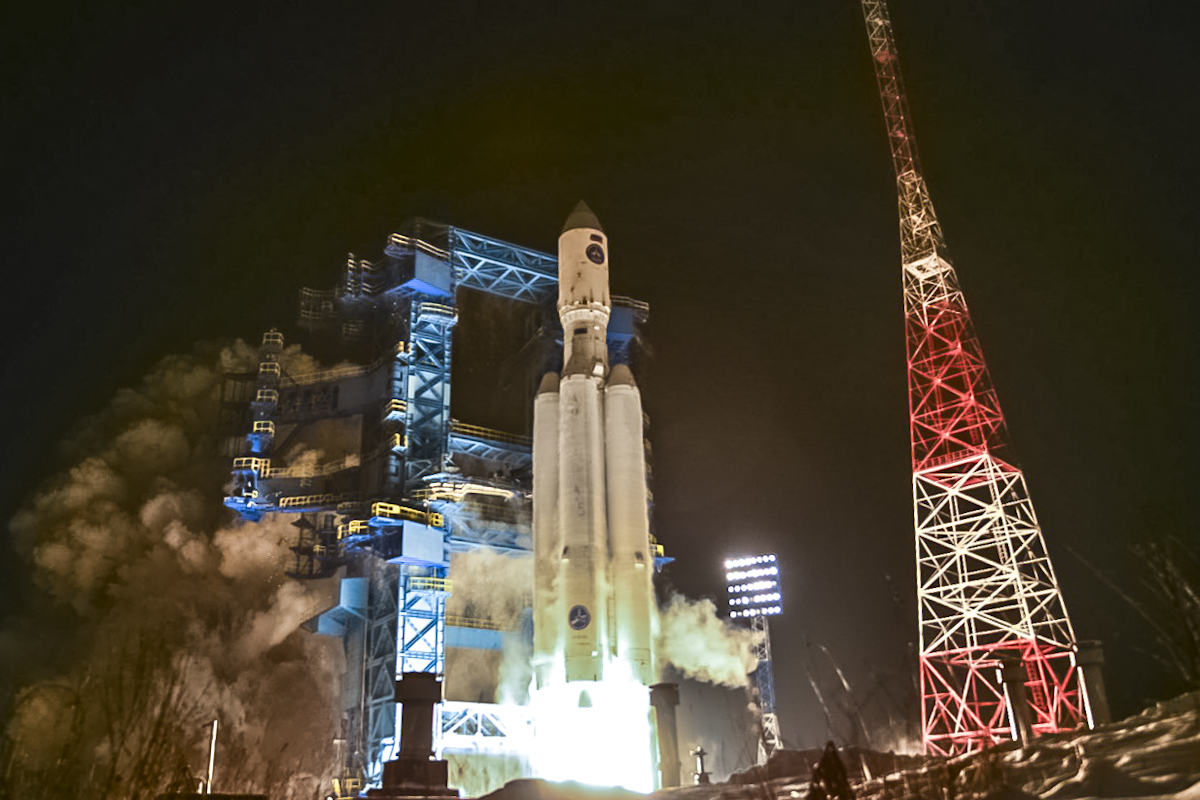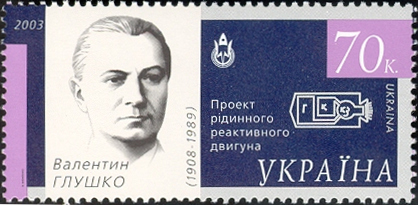|
RD-170
The RD-170 ( rus, РД-170, Ракетный Двигатель-170, Raketnyy Dvigatel-170) is the world's most powerful and heaviest liquid-fuel rocket engine. It was designed and produced in the Soviet Union by NPO Energomash for use with the Energia launch vehicle. The engine burns kerosene fuel and LOX oxidizer in four combustion chambers, all supplied by one single-shaft, single-turbine turbopump rated at in a staged combustion cycle. Shared turbopump Several Soviet and Russian rocket engines use the approach of clustering small combustion chambers around a single turbine and pump. During the early 1950s, many Soviet engine designers, including Valentin P. Glushko, faced problems of combustion instability while designing bigger thrust chambers. At that time, they solved the problem by using a cluster of smaller thrust chambers. Variants RD-170 The RD-170 engine featured four combustion chambers and was developed for use on the Energia launch vehicle – both the ... [...More Info...] [...Related Items...] OR: [Wikipedia] [Google] [Baidu] |
NPO Energomash
NPO Energomash “V. P. Glushko” is a major Russian rocket engine manufacturer. The company primarily develops and produces liquid propellant rocket engines. Energomash originates from the Soviet design bureau OKB-456, which was founded in 1946. NPO Energomash acquired its current name on May 15, 1991, in honor of its former chief designer Valentin Glushko. Energomash is noted for its long history of large scale LOX/Kerosene engine development. Notable examples are the RD-107/ RD-108 engines used on the R-7, Molniya and Soyuz rocket families, and the RD-170, RD-171 and RD-180 engines used on the Energia, Zenit and Atlas V launch vehicles. , the company remained largely owned by the federal government of Russia, but RSC Energia owned approximately 14% of the total shares. , NPO Energomash employed approximately 5500 workers at its headquarters in Khimki, Moscow and its satellite facilities in Samara, Perm, and St. Petersburg. On 4 August 2016, the company an ... [...More Info...] [...Related Items...] OR: [Wikipedia] [Google] [Baidu] |
RD-180
The RD-180 ( rus, РД-180, Ракетный Двигатель-180, Raketnyy Dvigatel-180) is a rocket engine designed and built in Russia. It features a dual combustion chamber, dual- nozzle design and is fueled by a RP-1/ LOX mixture. The RD-180 is derived from the RD-170/RD-171 line of rocket engines, which were used in the Soviet Energia launch vehicle and are still in use in the Ukrainian Zenit launch vehicles. RD-180 engines are also used for the first stage of the American Atlas V launch vehicle, which is being phased out due to the national security implications of being reliant on foreign parts which became of concern after the Russian invasion of Crimea. , Russian supplies and maintenance have been discontinued as the result of trade sanctions caused by the 2022 Russian invasion of Ukraine. History The roots of the RD-180 rocket engine extend back into the Soviet Energia launch vehicle project. The RD-170, a four-chamber engine, was developed for use on the stra ... [...More Info...] [...Related Items...] OR: [Wikipedia] [Google] [Baidu] |
Energia (rocket)
Energia (russian: Энергия, Energiya, Energy; GRAU 11K25) was a 1980s super-heavy lift launch vehicle. It was designed by NPO Energia of the Soviet Union as part of the Buran program for a variety of payloads including the Buran spacecraft. Control system main developer enterprise was the Khartron NPO "Electropribor". The Energia used four strap-on boosters each powered by a four-chamber RD-170 engine burning kerosene/ LOX, and a central core stage with four single-chamber RD-0120 (11D122) engines fueled by liquid hydrogen/LOX. The launch vehicle had two functionally different operational variants: Energia-Polyus, the initial test configuration, in which the Polyus system was used as a final stage intended to put the payload into orbit, and Energia-Buran, in which the ''Buran'' orbiter was the payload and the source of the orbit insertion impulse. The launch vehicle had the capacity to place about 100 tonnes in Low Earth orbit, up to 20 tonnes to geostationary or ... [...More Info...] [...Related Items...] OR: [Wikipedia] [Google] [Baidu] |
Angara (rocket Family)
The Angara rocket family (Russian: Ангара) is a family of launch vehicles being developed by the Moscow-based Khrunichev State Research and Production Space Center. The launch vehicles are to put between and into low Earth orbit and are intended, along with Soyuz-2 variants, to replace several existing launch vehicles. History After the dissolution of the Soviet Union, many formerly Soviet launch vehicles were built in or required components from companies now located in Ukraine, such as Yuzhnoye Design Bureau, which produced Zenit-2, and Yuzhmash, which produced Dnepr and Tsyklon. Additionally, the Soviet Union's main spaceport, Baikonur Cosmodrome, was located in Kazakhstan, and Russia encountered difficulties negotiating for its use. This led to the decision in 1992 to develop a new entirely Russian launch vehicle, named Angara, to replace the launch vehicles now built outside of the country, and ensure Russian access to space without Baikonur. It was dec ... [...More Info...] [...Related Items...] OR: [Wikipedia] [Google] [Baidu] |
Comparison Of Orbital Rocket Engines
This page is an incomplete list of orbital rocket engine data and specifications. Current, Upcoming, and In-Development rocket engines Retired and canceled rocket engines See also * Comparison of orbital launch systems * Comparison of orbital launchers families * Comparison of crewed space vehicles * Comparison of space station cargo vehicles * Comparison of solid-fuelled orbital launch systems This article contains the lift launch systems constructed by some solid fuel stages except the final stage. All stages solid fueled :* Including suborbital mission All stages solid fueled except uppermost stage See also * Comparison of o ... * List of space launch system designs * List of orbital launch systems Notes References {{DEFAULTSORT:Orbital rocket engine comparison Spaceflight Technological comparisons Space lists Rocket engines ... [...More Info...] [...Related Items...] OR: [Wikipedia] [Google] [Baidu] |
Valentin Petrovich Glushko
Valentin Petrovich Glushko (russian: Валенти́н Петро́вич Глушко́; uk, Валентин Петрович Глушко, Valentyn Petrovych Hlushko; born 2 September 1908 – 10 January 1989) was a Soviet engineer and the main designer of rocket engines in the Soviet space program during the heights of the Space Race between United States and the Soviet Union. Biography At the age of fourteen he became interested in aeronautics after reading novels by Jules Verne. He is known to have written a letter to Konstantin Tsiolkovsky in 1923. He studied at an Odessa trade school, where he learned to be a sheet metal worker. After graduation he apprenticed at a hydraulics fitting plant. He was first trained as a fitter, then moved to lathe operator. During his time in Odessa, Glushko performed experiments with explosives. These were recovered from unexploded artillery shells that had been left behind by the White Guards during their retreat. From 1924 to 1925 he ... [...More Info...] [...Related Items...] OR: [Wikipedia] [Google] [Baidu] |
Soviet Inventions
This timeline of Russian Innovation encompasses key events in the history of technology in Russia, from the Grand Duchy of Moscow up to the Russian Federation. The entries in this timeline fall into the following categories: * indigenous inventions, like airliners, AC transformers, radio receivers, television, artificial satellites, ICBMs * uniquely Russian products, objects and events, like Saint Basil's Cathedral, Matryoshka dolls, Russian vodka * products and objects with superlative characteristics, like the Tsar Bomba, the AK-47, and the Typhoon-class submarine * scientific and medical discoveries, like the periodic law, vitamins and stem cells This timeline includes scientific and medical discoveries, products and technologies introduced by various peoples of Russia and its predecessor states, regardless of ethnicity, and also lists inventions by naturalized immigrant citizens. Certain innovations achieved internationally may also appear in this timeline in ca ... [...More Info...] [...Related Items...] OR: [Wikipedia] [Google] [Baidu] |
Staged Combustion Cycle (rocket)
The staged combustion cycle (sometimes known as topping cycle, preburner cycle, or closed cycle) is a power cycle of a bipropellant rocket engine. In the staged combustion cycle, propellant flows through multiple combustion chambers, and is thus combusted in stages. The main advantage relative to other rocket engine power cycles is high fuel efficiency, measured through specific impulse, while its main disadvantage is engineering complexity. Typically, propellant flows through two kinds of combustion chambers; the first called preburner and the second called main combustion chamber. In the preburner, a small portion of propellant, usually fuel-rich, is partly combusted, and the increasing volume flow is used to drive the turbopumps that feed the engine with propellant. The gas is then injected into the main combustion chamber and combusted completely with the other propellant to produce thrust. Tradeoffs The main advantage is fuel efficiency due to all of the propellant fl ... [...More Info...] [...Related Items...] OR: [Wikipedia] [Google] [Baidu] |
Staged Combustion Cycle
The staged combustion cycle (sometimes known as topping cycle, preburner cycle, or closed cycle) is a power cycle of a bipropellant rocket engine. In the staged combustion cycle, propellant flows through multiple combustion chambers, and is thus combusted in stages. The main advantage relative to other rocket engine power cycles is high fuel efficiency, measured through specific impulse, while its main disadvantage is engineering complexity. Typically, propellant flows through two kinds of combustion chambers; the first called preburner and the second called main combustion chamber. In the preburner, a small portion of propellant, usually fuel-rich, is partly combusted, and the increasing volume flow is used to drive the turbopumps that feed the engine with propellant. The gas is then injected into the main combustion chamber and combusted completely with the other propellant to produce thrust. Tradeoffs The main advantage is fuel efficiency due to all of the propellant ... [...More Info...] [...Related Items...] OR: [Wikipedia] [Google] [Baidu] |
Irtysh (rocket)
Irtysh (), also named Soyuz-5 (), formerly codenamed Fenix in Russian and Sunkar () in Kazakh, is a planned Russian rocket that is being developed by JSC SRC Progress within the "Project Feniks" (). Initially it will replace the capability of Zenit-2 and Proton Medium, and in the future will serve as the base of a super heavy-lift launch vehicle rocket (Yenisei) to match the Energia/ Buran capabilities. , Irtysh is expected to launch from the Baikonur Baiterek, the ex Zenit-2 launch site, in a partnership with the government of Kazakhstan, with a planned debut in late 2023. Project organization The current proposal is led by JSC SRC Progress, with support by Khrunichev and Makeyev, additionally, RSC Energia would handle the launch site, and supply the Blok DM-03, while Roscosmos would finance the development through the Project Fenicks under the 2016–2025 Russian space master plan. KazCosmos would also be a partner since the initial launch pad would be at Baikonur Cosmo ... [...More Info...] [...Related Items...] OR: [Wikipedia] [Google] [Baidu] |
Soyuz-5 (rocket)
Irtysh (), also named Soyuz-5 (), formerly codenamed Fenix in Russian and Sunkar () in Kazakh, is a planned Russian rocket that is being developed by JSC SRC Progress within the "Project Feniks" (). Initially it will replace the capability of Zenit-2 and Proton Medium, and in the future will serve as the base of a super heavy-lift launch vehicle rocket (Yenisei) to match the Energia/ Buran capabilities. , Irtysh is expected to launch from the Baikonur Baiterek, the ex Zenit-2 launch site, in a partnership with the government of Kazakhstan, with a planned debut in late 2023. Project organization The current proposal is led by JSC SRC Progress, with support by Khrunichev and Makeyev, additionally, RSC Energia would handle the launch site, and supply the Blok DM-03, while Roscosmos would finance the development through the Project Fenicks under the 2016–2025 Russian space master plan. KazCosmos would also be a partner since the initial launch pad would be at Baikonur Cosmo ... [...More Info...] [...Related Items...] OR: [Wikipedia] [Google] [Baidu] |
Naro-1
Naro-1 ( ko, 나로호), previously designated the Korea Space Launch Vehicle or KSLV (also KSLV-1), was South Korea's first carrier rocket, and the first South Korean launch vehicle to achieve Earth orbit. On January 30, 2013, the third Naro-1 vehicle built successfully placed STSAT-2C into low Earth orbit. The first stage was a modified Russian Angara URM. The solid-fuel second stage was built by KARI, the national space agency of South Korea, and Korean Air. Neither the maiden flight on August 25, 2009, nor the second flight on June 10, 2010, reached orbit. The third flight on January 30, 2013, successfully reached orbit. The launches took place from the Naro Space Center. The official name of the first KSLV rocket, KSLV-I, is Naro, which is the name of the region in which Naro Space Center is located. Since Naro's retirement, the South Korean government has announced the rocket Nuri as its replacement and successor. History In 1992, Republic of Korea developed and l ... [...More Info...] [...Related Items...] OR: [Wikipedia] [Google] [Baidu] |





.jpg)